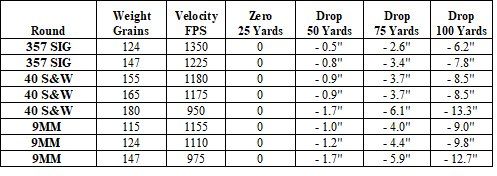pblanc and I had a private conversation (which I initiated in an attempt to not further add chaff to the existing discussion). During that discussion he talked about his experiences when shooting the same rounds through the same gun. His observed results that seemed to run contrary what one might expect if all other things were equal. As I did some additional digging following that offline discussion, it became obvious that some other variables might be at play.
In searching through ballistic charts (showing how rounds arc and drop -- due to sight placement, gravity. bullet size, weight, shape and velocity) -- appears that the .40 bullet path follows a different (slightly higher?) arc, and drops more quickly after the zero point (25 yards) than does the .357SIG round. It's long been held that the .357SIG round flies a flatter trajectory.
The following chart was extracted from the following materials; a link is provided:
http://www.gunnersden.com/index.htm.handgun-ballistics.html
The following information came from this site:
https://www.realgunreviews.com/sig-sauer-sight-heights-sight-numbers/
It tells me that the standard SIGs use the following:
9mm & .357 SIG: #8 front / #8 rear
.40 S&W & .45 A
CP: #6 front / #8 rear
For the SIG X-RAY sights (like the ones that come on the Legion series pistols), things seem to be a bit different, and the model does seem to matter:
P226 Legion 9mm (DA/SA & SAO): #8 front / #8 rear
P226 Legion .40 DA/SA & P229 Legion 9mm DA/SA: #6 front / #6 rear
But the author notes that there can be other variations.
This table, from
https://www.realgunreviews.com/sig-sauer-sight-heights-sight-numbers/ shows the actual heights of each SIG front and rear sight number. The front heights shown are the actual heights of the sight — including the dovetail base, not just the blade. Front and rear sights with the same numbers are NOT the same height.
According to various folks each step down or up in the number on a front sight (given that the rear sights are the same) should result in a 1" rise or drop at 25 yards, respectively, if the round stays the same.
That would make me think that if a .357 factory barrel is used in a .40 slide, it might NATURALLY shoot 1"-2" lower than a .40 round fired from the same slide. The reverse might also be true -- if a .357 slide using a .40 barrel might cause the .40 round to hit 1"-2" higher. No matter which slide is used, the rounds should give different points of impact when mounted in the slide for the other caliber based on the performance specs above.
The sight differences might account for the many variances and difference we see discussed when this topic comes up when barrels are switched. Or, it may simply be that this continues to confuse me and others.
Conversion barrels may be different than factory barrels -- might -- and if there is a difference it could conceivably vary by barrel-maker. I don't know how or where CONVERSION barrels fit in this discussion. About the only difference between a .40 SIG slide and a .357 Sig slide is the sights, and the barrels are supposedly interchangeable. When I"ve owned factory barrels for the .40 and .357 SIG rounds, they seemed identical (except for bore size).
The only part of this exercise in data collection that doesn't make sense to me is the fact that the front sight on the .40 slide is .28 mm higher than the front sight on the .357 SIG (which would seemingly cause a slightly lower point of impact than if the front and rear sights used the same #, like the .357 SIG model does. That difference is a quirk whose existence isn't intuitively obvious to me. (As shown above, front and rear sights with the same #s are not the same height.)



